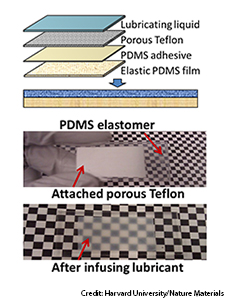
The adaptive tunable fabric consists of several layers. The dry substrate (top) becomes transparent after infusion with the lubricant (bottom).
A new type of adaptive film inspired by tears can turn its transparency on and off, repel water and ice as conditions change, and clean itself, say researchers at Harvard University (U.S.A.). The ability to control optical transparency and wettability—much like the film of moisture coating our eyes—could enable the design of adaptive materials for a range of applications, such as a tent that becomes opaque on a dry sunny day and becomes water repellent and more transparent on a dim rainy day.
Professor of materials science Joanna Aizenberg and colleagues recently published an article describing a new class of materials that feature multifunctional adaptive surfaces comprised of a low-surface-energy liquid film infused onto a nanoporous elastic substrate (Nature Mat., doi: 10.1038/nmat3598). With bending or stretching of the substrate, the liquid flows into tiny open pores in the nanosurface, causing the surface to roughen and become opaque. A graded mechanical stimulus can finely tune the optical transparency and the surface tension of the film.
The team measured optical transmission using a fiber spectrophotometer for visible wavelengths of 400 to 850 nm and a FLIR SC500 infrared camera for wavelengths from 2.5 to 5.1 μm. The latter demonstrated that the surface effectively scatters thermal signal from a hot background of 50°C as it is stretched. Furthermore, the fabric demonstrates an anti-fingerprint ability, whereas a print left in the stretched state is “self-healed” as the fluid flows back into the gaps in the unstretched state.
Click here to see a video of the bending deformation of a liquid-infused membrane and its corresponding transparency changes.
